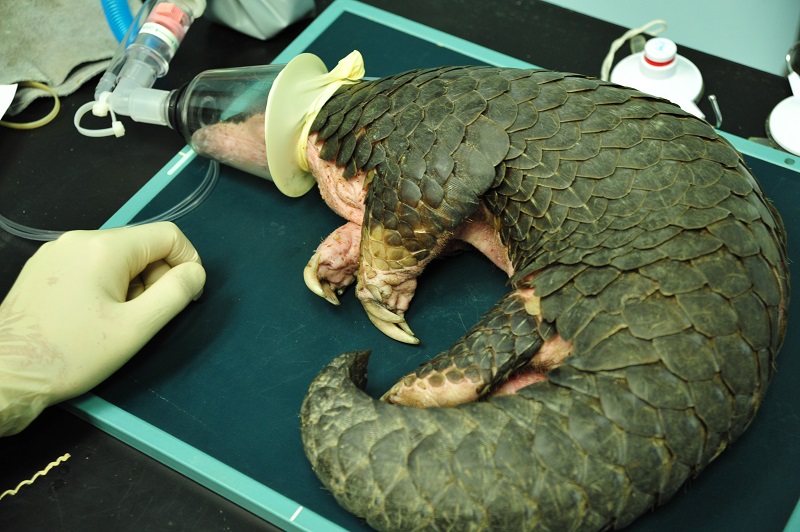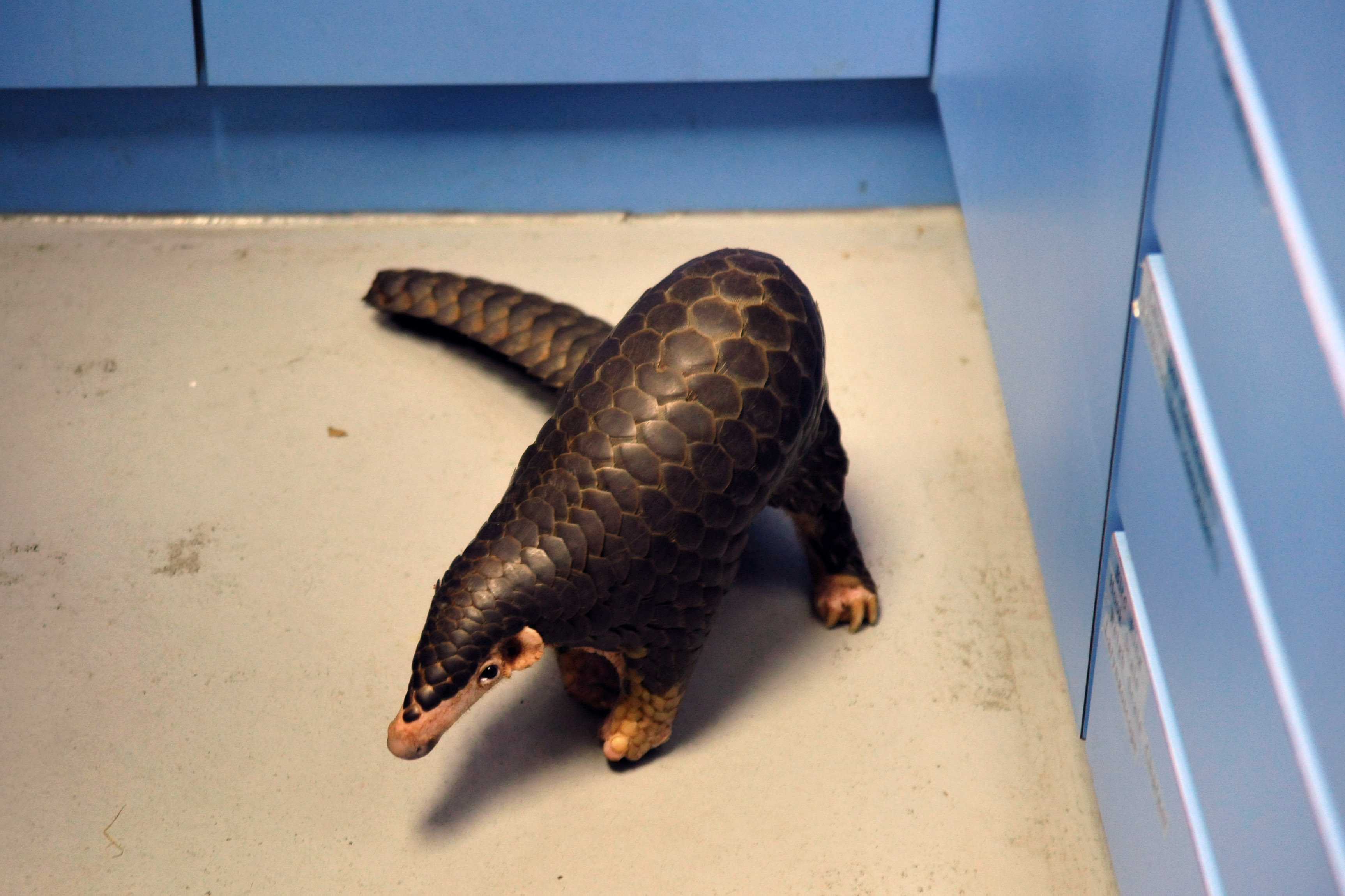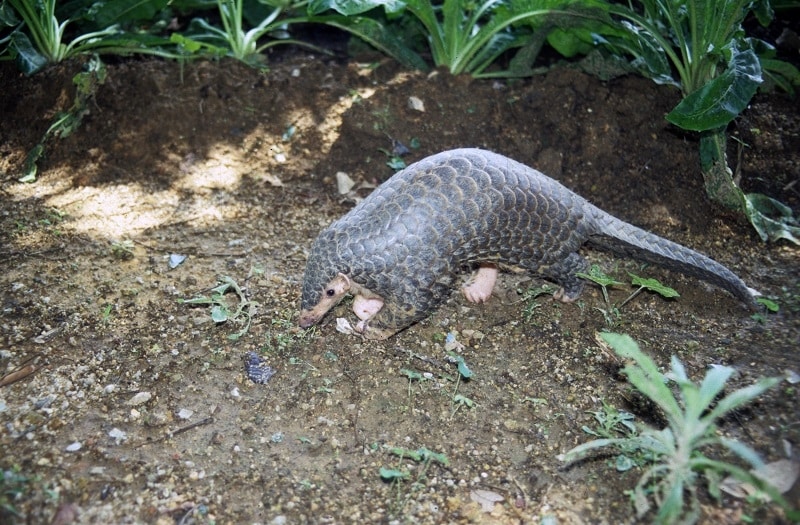'Fortunate Pangolin' survives after dog attack
On 23 July 2014, a critically endangered Pangolin was successfully released back to the wild. A transmitter was attached to the Pangolin so that it could be tracked after release to determine its survival. Signals were picked up by Government researchers and data showed that the Pangolin was still alive a week after the release.
Striving to survive
On 13 July 2014, the Wild Animal Rescue Centre (Rescue Centre) received the injured Pangolin from the Agriculture, Fisheries and Conservation Department (AFCD). The tip of its tail was found missing during the initial veterinary check and the wound was severely infected. Some scales were broken as well. It was believed to have been attacked by a feral dog, which had managed to bite the tip of its tail off. Shortly after arrival it underwent a surgery to have the injured part treated.
Health condition was not good after the surgery as the infection was not reacting to antibiotic treatment.
 The injured Pangolin receiving health check by the Rescue Team
The injured Pangolin receiving health check by the Rescue Team
Despite later improvements which saw the infection coming under control, few days after the surgery, the Pangolin had quite a thorny problem - it was not eating. Although it started to lose weight, it is fortunate that the Pangolin can store body fat and are able to go without food for many days. It was quite active and walked around the hospital floor and stayed alert to the rescue staff who took care of it.
 The Pangolin during recovery walking around the Veterinary hospital
The Pangolin during recovery walking around the Veterinary hospital
Back to the wild
The treated tail recovered well from the injury after about a week. To prevent its weight from further dropping, the Rescue Team decided to release it back to the wild. On the day of release, they attached a transmitter on the back of its tail to enable it to be radio tracked in order to find out its status in the wild. Its weight dropped from 4.4kg to 3.7kg in 10 days but this was still an acceptable weight for a healthy Pangolin.

KFBG staff attaching a transmitter on the back of the pangolin before release
Radio tracking of the Pangolin has been undertaken by the AFCD. We hope that the Pangolin will manage to stay away from feral dogs to improve its fitness.
Native wildlife under threat
Recently, increasing number of feral dogs in Hong Kong has threatened local wildlife. Animals like Barking Deer, Porcupines, Pangolins and Masked Palm Civets are always reported to be injured by them. Feral dogs are carnivorous predators. They hunt for a variety of animals including mammals, birds and herbivores. Most stray dogs are either abandoned pet dogs or owned by locals who do not neuter their dogs. When unneutered pets interbreed with feral dogs, they produce litters of unwanted puppies. It further puts native wildlife in a dangerous situation.
How can we help?
The Chinese Pangolin has upgraded from Endangered (EN) to Critically Endangered (CR) in the IUCN Red Data list due to unsustainable poaching for meat and especially their scales for Traditional Chinese Medicine. From now on, please stop consuming any products made from them!
If you are a pet dog’s owner, please be responsible by not abandoning any pet dogs or puppies. Neutering your pets can also help to prevent unexpected mating and pregnancy between pets.
Last but not least, if you find any injured wild animals, please report to the AFCD (Hotline: 1823), SPCA (Hotline: 2711 1000) or the Rescue Center at KFBG (Hotline: 2483 7200). Your decision is critical and can give a chance for them to survive.
.jpg)
 Pangolin scales are commonly used to scratch mosquito bites to stop itchiness or ground into a powder to help with ailments.
Pangolin scales are commonly used to scratch mosquito bites to stop itchiness or ground into a powder to help with ailments.
Animal Profile
Lateral-view-3_resizev.jpg)

Common Name: Chinese Pangolin
Scientific Name: Manis pentadactyla
Distribution: Southeast Asia and Southern China; restricted distribution in Hong Kong
Habitat: Humid woodlands with dead trees and plenty of ants and termites
Features: Body is covered with hard gray armor-like scales and has a long sticky tongue that extends as long as 20 cm; curl up into a ball when threatened
Diet: Insectivorous; mainly feeds on ants and termites
Major threats: Hunting and poaching for food and scales; habitat loss caused by human activity
Conservation status: IUCN Red List: Critically Endangered; CITES Appendix II; Protected by Wild Animals Protection Ordinance (Cap. 170) in Hong Kong

